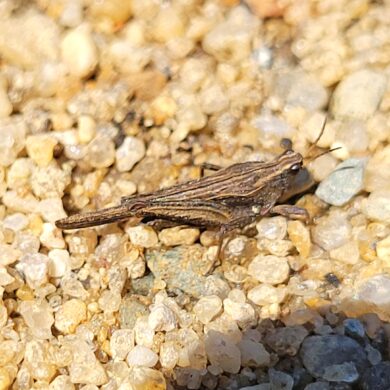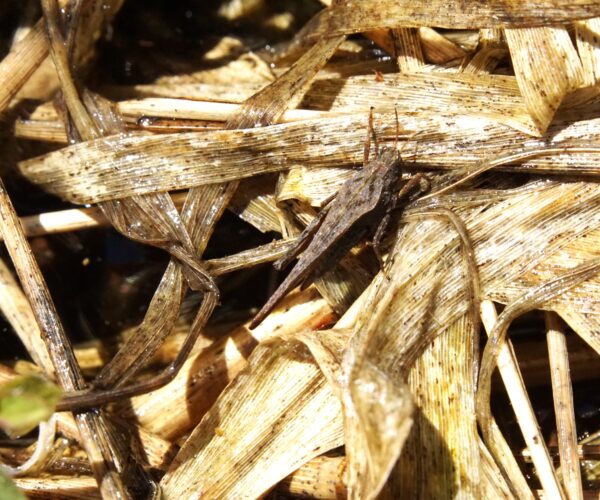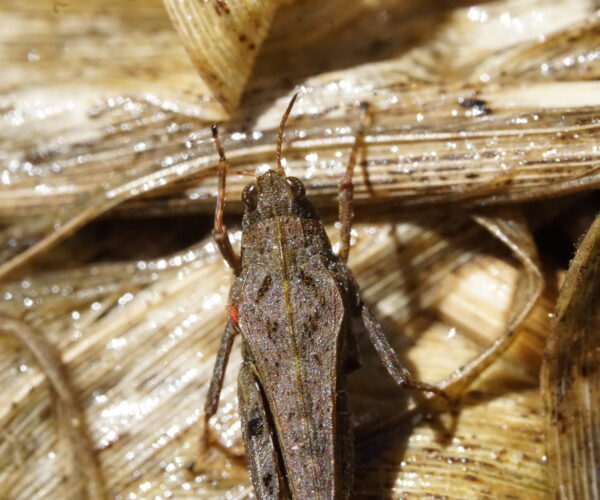
Tetrix subulata
New Grasshopper Species for the Vineyard
On a warm, sunny afternoon on the last day of May, 2024, I joined my BiodiversityWorks colleague Silas Beers in Aquinnah to count birds for the International Shorebird Survey. Making the reasonable but unfortunate decision to leave my close-up camera lens in the car, we walked down a private road toward our survey route’s starting point.
But about 100 yards from the car, I noticed a flash of motion on the dirt road at my feet. A tiny grasshopper, disturbed by our passage, leaped to safety, augmenting its jump with an enthusiastic if not very effective flutter of wings. Tracking the insect to its landing point, I was startled to see what was clearly a pygmy grasshopper – a member of the family Tetrigidae. Even more startling was the elongated, delicate structure of this insect, strongly suggestive of the slender or awl-shaped pygmy grasshopper, Tetrix subulata.
An strange-looking and little-known family, Tetrigidae earn their “pygmy” name by being truly tiny. Large Tetrigids approach three-quarters of an inch in length as adults; small ones may barely exceed a quarter-inch. If you do manage to spot one, the family is distinctive in structure: the pronotum, which is the exoskeleton plate on top of the thorax, is elongated in Tetrigids, extending at least to the end of the abdomen and, in some species and individuals, well beyond. The wings, which are surprisingly often functional, are wholly concealed at rest beneath this odd structure. But given the small size and secretive habits of these miniature grasshoppers, finding and studying one is not easy.
Pygmy grasshoppers are not well represented on Martha’s Vineyard. One species, Nomotettix cristatus, or crested pygmy grasshopper, is reasonably common (if hard to spot) in barrens habitat (nearly all Vineyard records are from Correllus State Forest). Tettigidea lateralis (black-sided pygmy grasshopper) is known only from a single “research-grade” observation in iNaturalist from a bog in Aquinnah. And the ornate grouse locust (Tetrix ornata) has likewise been documented on the Vineyard only once, when several individuals were found in a strawberry patch at a West Tisbury farm. These grasshoppers are presumed to have been imported with the strawberry plants, which originated in central Massachusetts, and no native population of T. ornata is known to exist on the Vineyard. That’s it.
So you well believe that having a suspected Tetrix subulata at my feet temporarily drove all thoughts of shorebirds out of my mind! Deeply regretting the decision to leave my macro lens in the car, I decided that my best bet for getting some kind of documentation before the insect disappeared was to try for cell phone photos. Maneuvering carefully to the sunny side of the insect, for the best possible light, I managed a few close-range phone shots before another wing-augmented leap took the tiny grasshopper into the roadside vegetation, never to be seen again.
Tetrix subulata (Lexington, Massachusetts, May 7, 2021)
Happily, while the resulting shots had the dubious quality of most phone photographs, they were good enough to show diagnostic characters: attenuated shape, a pronotum cut straight across behind the head rather than extending over the base of the head as an angular apex, a clear median ridge on the pronotum, and the absence of an extension of that ridge in front of the forehead, between the eyes. The iNaturalist observation I created from the photos rapidly received ID confirmation from Brandon Woo, an Orthoptera expert who has been incredibly generous in helping me learn grasshoppers, crickets, and katydids. This represented the 68th species of Orthoptera documented on Martha’s Vineyard.
As a group, Tetrigidae tends to associate with wetlands (the barrens-loving Nomotettix cristatus is an exception to this rule). Very high water levels from the wet weather earlier this spring likely drove this tiny grasshopper onto the road, where I had an opportunity to encounter it. But in general, their association with wetlands makes pygmy grasshoppers, elusive to start with due to their size, even harder to find and observe closely. It seems probable that most or all of the Tetrigids known from Martha’s Vineyard are dramatically under-reported. Alert observation along wetland edges, especially when wet conditions have overfilled swamps and bogs, could well lead to more records of these interesting grasshoppers, and perhaps the discovery of additional species in this group.
Matt Pelikan is the director of the Martha’s Vineyard Atlas of Life project at BiodiversityWorks. He has been studying the Orthoptera (crickets, katydids, and grasshoppers) of Martha’s Vineyard since 2010.


